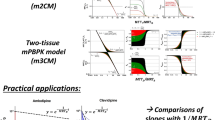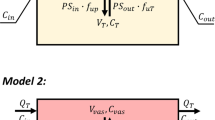Abstract
In our companion paper, we described the theoretical basis for tissue lumping in whole-body physiologically based pharmacokinetic (WB-PBPK) models and found that Kdet, a coefficient for determining the number of tissue groups of distinct transit time in WB-PBPK models, was related to the fractional change in the terminal slope (FCT) when tissues were progressively lumped from the longest transit time to shorter ones. This study was conducted to identify the practical threshold of Kdet by applying the lumping theory to plasma/blood concentration-time relationships of 113 model compounds collected from the literature. We found that drugs having Kdet < 0.3 were associated with FCT < 0.1 even when all peripheral tissues were lumped, resulting in comparable plasma concentration-time profiles between one-tissue minimal PBPK (mPBPK) and WB-PBPK models. For drugs with Kdet ≥ 1, WB-PBPK profiles appeared similar with two-tissue mPBPK models by applying the rule of FCT < 0.1 for lumping slowly equilibrating tissues. The two-tissue mPBPK model also appeared appropriate in terms of concentration-time profiles for drugs with 0.3 ≤ Kdet < 1, although, some compounds (15.9% of the total cases), but not all, in this range showed a slight (maximum of 18.9% of the total AUC) deviation from WB-PBPK models, indicating that the two-tissue model, with caution, could still be used for those cases. Comparison of kinetic parameters between traditional (model-fitting) and current (theoretical calculation) mPBPK analyses revealed their significant correlations. Collectively, these observations suggest that the number of tissue groups could be determined based on the Kdet/FCT criteria, and plasma concentration-time profiles from WB-PBPK could be calculated using equations significantly less complex.
Graphical abstract







Similar content being viewed by others
References
Levy G, Gibaldi M, Jusko WJ. Multicompartment pharmacokinetic models and pharmacologic effects. J Pharm Sci. 1969;58(4):422–4.
Benet LZ. General treatment of linear mammillary models with elimination from any compartment as used in pharmacokinetics. J Pharm Sci. 1972;61(4):536–41.
Cao Y, Jusko WJ. Applications of minimal physiologically-based pharmacokinetic models. J Pharmacokinet Pharmacodyn. 2012;39(6):711–23. https://doi.org/10.1007/s10928-012-9280-2.
Sager JE, Yu J, Ragueneau-Majlessi I, Isoherranen N. Physiologically based pharmacokinetic (PBPK) modeling and simulation approaches: a systematic review of published models, applications, and model verification. Drug Metab Dispos. 2015;43(11):1823–37.
Riegelman S, Loo J, Rowland M. Shortcomings in pharmacokinetic analysis by conceiving the body to exhibit properties of a single compartment. J Pharm Sci. 1968;57(1):117–23.
Hirtz J. The fate of drugs in the organism. A bibliographic survey complied by the Societe´ Fran¸aise des Sciences et Techniques Pharmaceutique, Working group under the chairmanship of HIRTZ. Dekker New York; 1974.
Segre G. Pharmacokinetics—compartmental representation. Pharmacol Ther. 1982;17(1):111–27.
Vaughan D, Dennis M. Number of exponential terms describing the solution of an N-compartmental mammillary model: Vanishing exponentials. J Pharmacokinet Biopharm. 1979;7(5):511–25.
Wagner JG. Linear pharmacokinetic models and vanishing exponential terms: Implications in pharmacokinetics. J Pharmacokinet Biopharm. 1976;4(5):395–425.
Jeong Y-S, Kim M-S, Chung S-J. Determination of the number of tissue groups of kinetically distinct transit time in whole-body physiologically-based pharmacokinetic (PBPK) models I: Theoretical consideration of bottom-up approach of lumping tissues in whole-body PBPK. AAPS J. 2022. https://doi.org/10.1208/s12248-022-00732-y.
Lobell M, Sivarajah V. In silico prediction of aqueous solubility, human plasma protein binding and volume of distribution of compounds from calculated pKa and AlogP98 values. Mol Diversity. 2003;7(1):69–87.
Jamei M, Marciniak S, Feng K, Barnett A, Tucker G, Rostami-Hodjegan A. The Simcyp® population-based ADME simulator. Expert Opin Drug Metab Toxicol. 2009;5(2):211–23.
Colclough N, Ruston L, Wood JM, MacFaul PA. Species differences in drug plasma protein binding. Med Chem Commun. 2014;5(7):963–7.
Uchimura T, Kato M, Saito T, Kinoshita H. Prediction of human blood-to-plasma drug concentration ratio. Biopharm Drug Dispos. 2010;31(5-6):286–97. https://doi.org/10.1002/bdd.711.
Kerns EH, Di L, Petusky S, Farris M, Ley R, Jupp P. Combined application of parallel artificial membrane permeability assay and Caco-2 permeability assays in drug discovery. J Pharm Sci. 2004;93(6):1440–53.
Fujikawa M, Ano R, Nakao K, Shimizu R, Akamatsu M. Relationships between structure and high-throughput screening permeability of diverse drugs with artificial membranes: application to prediction of Caco-2 cell permeability. Bioorg Med Chem. 2005;13(15):4721–32. https://doi.org/10.1016/j.bmc.2005.04.076.
Jeong Y-S, Yim C-S, Ryu H-M, Noh C-K, Song Y-K, Chung S-J. Estimation of the minimum permeability coefficient in rats for perfusion-limited tissue distribution in whole-body physiologically-based pharmacokinetics. Eur J Pharm Biopharm. 2017;115:1–17.
Rodgers T, Leahy D, Rowland M. Physiologically based pharmacokinetic modeling 1: Predicting the tissue distribution of moderate-to-strong bases. J Pharm Sci. 2005;94(6):1259–76. https://doi.org/10.1002/jps.20322.
Rodgers T, Rowland M. Physiologically based pharmacokinetic modelling 2: predicting the tissue distribution of acids, very weak bases, neutrals and zwitterions. J Pharm Sci. 2006;95(6):1238–57. https://doi.org/10.1002/jps.20502.
Øie S, Tozer TN. Effect of altered plasma protein binding on apparent volume of distribution. J Pharm Sci. 1979;68(9):1203–5.
Brown R, Delp M, Lindstedt S, Rhomberg L, Beliles R. Physiological parameter values for physiologically based pharmacokinetic models. Toxicol Ind Health. 1997;13407:407–84.
Nestorov IA, Aarons LJ, Arundel PA, Rowland M. Lumping of whole-body physiologically based pharmacokinetic models. J Pharmacokinet Biopharm. 1998;26(1):21–46.
Veng-Pedersen P, Gillespie WR. Single pass mean residence time in peripheral tissues: a distribution parameter intrinsic to the tissue affinity of a drug. J Pharm Sci. 1986;75(12):1119–26.
Pilari S, Huisinga W. Lumping of physiologically-based pharmacokinetic models and a mechanistic derivation of classical compartmental models. J Pharmacokinet Pharmacodyn. 2010;37(4):365–405.
Gueorguieva I, Nestorov IA, Rowland M. Reducing whole body physiologically based pharmacokinetic models using global sensitivity analysis: diazepam case study. J Pharmacokinet Pharmacodyn. 2006;33(1):1–27.
Björkman S. Reduction and lumping of physiologically based pharmacokinetic models: prediction of the disposition of fentanyl and pethidine in humans by successively simplified models. J Pharmacokinet Pharmacodyn. 2003;30(4):285–307.
Brochot C, Tóth J, Bois FY. Lumping in pharmacokinetics. J Pharmacokinet Pharmacodyn. 2005;32(5-6):719–36.
Jeong Y-S, Jusko WJ. Meta-assessment of metformin absorption and disposition pharmacokinetics in nine species. Pharmaceuticals. 2021;14(6):545.
Kong AN, Jusko WJ. Definitions and applications of mean transit and residence times in reference to the two-compartment mammillary plasma clearance model. J Pharm Sci. 1988;77(2):157–65.
Berezhkovskiy LM. Prediction of drug terminal half-life and terminal volume of distribution after intravenous dosing based on drug clearance, steady-state volume of distribution, and physiological parameters of the body. J Pharm Sci. 2013;102(2):761–71.
Fleishaker JC, Smith RB. Compartmental model analysis in pharmacokinetics. J Clin Pharmacol. 1987;27(12):922–6.
Funding
This study was supported by the Korea Environment Industry & Technology Institute (KEITI) through the project for BioMarkers TRANSLation of consumer chemicals/ft.life-stage PBPK modeling (BioTranSL/PBPK) (NO. 2022002970003).
Author information
Authors and Affiliations
Contributions
Yoo-Seong Jeong: Conceptualization, methodology, formal analysis, investigation, data curation, writing-original draft, writing-review & editing, visualization
Min-Soo Kim: Methodology, software, formal analysis, data curation, writing-review & editing, visualization
Suk-Jae Chung: Conceptualization, methodology, formal analysis, writing-original draft, writing-review & editing, supervision, project administration, funding acquisition
Corresponding author
Ethics declarations
Conflict of Interest
The authors declare no competing interests.
Additional information
Publisher’s Note
Springer Nature remains neutral with regard to jurisdictional claims in published maps and institutional affiliations.
Appendix
Appendix
By applying Gauss elimination of the system matrix A of PBPK Model C [10], 10 eigenvalues were readily determined using Eq. 11:
When the two-tissue mPBPK model (Model D) is applicable, the eigenvalues (in terms of λ′; the roots corresponded to λα, λβ, and λγ) after tissue lumping could be determined by Eq. 12:
Rights and permissions
Springer Nature or its licensor holds exclusive rights to this article under a publishing agreement with the author(s) or other rightsholder(s); author self-archiving of the accepted manuscript version of this article is solely governed by the terms of such publishing agreement and applicable law.
About this article
Cite this article
Jeong, YS., Kim, MS. & Chung, SJ. Determination of the Number of Tissue Groups of Kinetically Distinct Transit Time in Whole-Body Physiologically Based Pharmacokinetic (PBPK) Models II: Practical Application of Tissue Lumping Theories for Pharmacokinetics of Various Compounds. AAPS J 24, 91 (2022). https://doi.org/10.1208/s12248-022-00733-x
Received:
Accepted:
Published:
DOI: https://doi.org/10.1208/s12248-022-00733-x




